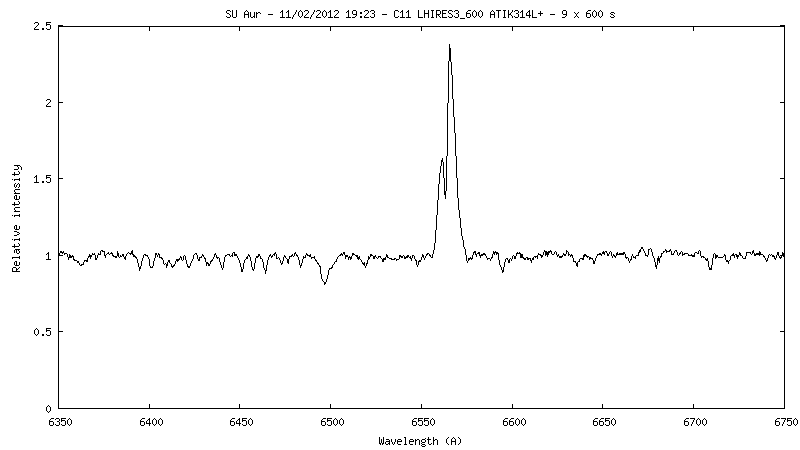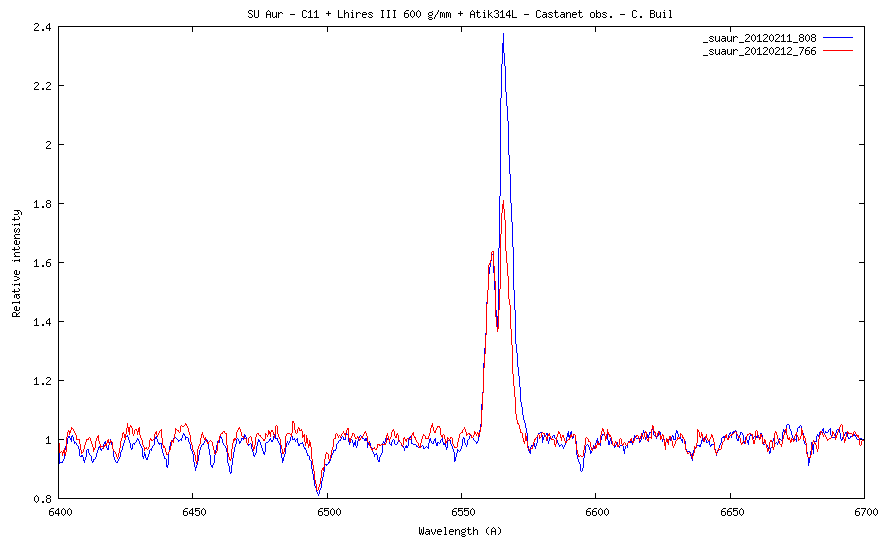Call for observation: SU Aur
-
Christian Buil
- Posts: 1432
- Joined: Mon Sep 26, 2011 6:59 pm
- Contact:
Call for observation: SU Aur
Hi all,
Hans Moritz Guenther (Harvard-Smithsonian Center for Astrophysics)
ask me for an urgent observation project.
Hans says:
In a few days, I have an observation of SU
Aur with XMM-Newton. It would be very useful to obtain simultaneous
spectroscopy of the Halpha line (more details on the science are below).
SU Aur is relatively bright (m_V = 9.5). It's an accreting, young
classical T Tauri star and we want to study the relation between X-ray
flares and accretion.
Thus, I am looking for someone who can take Halpha spectroscopy (which
traces the accretion) in short cadence during the XMM-Newton observation
(in UT 2012-02-15@20:31:13 to 2012-02-17@01:27:53).
The Halpha line of SU Aur is very broad (~500 km/s) and bright (about 2
times the continuum level).
See http://sprg.ssl.berkeley.edu/~cmj/html/suaur.html
for examples of SU Aur's H alpha line in past observations.
Thus, a resolving power ~50-100 km/s = 3000-6000 is totally sufficient,
but of course I don't say "no" to better spectrum.
However, short exposure times are also important, so that I can see if
the Halpha line profile changes, when an X-ray flare happens.
I can compile observation observations for Hans
Note : A Lhires III 300 to 1200 lines/mm seem a good instrumental
configuration for this target. But LISA or eShel (large telescope) can be
also usuable.
Christian Buil
Hans Moritz Guenther (Harvard-Smithsonian Center for Astrophysics)
ask me for an urgent observation project.
Hans says:
In a few days, I have an observation of SU
Aur with XMM-Newton. It would be very useful to obtain simultaneous
spectroscopy of the Halpha line (more details on the science are below).
SU Aur is relatively bright (m_V = 9.5). It's an accreting, young
classical T Tauri star and we want to study the relation between X-ray
flares and accretion.
Thus, I am looking for someone who can take Halpha spectroscopy (which
traces the accretion) in short cadence during the XMM-Newton observation
(in UT 2012-02-15@20:31:13 to 2012-02-17@01:27:53).
The Halpha line of SU Aur is very broad (~500 km/s) and bright (about 2
times the continuum level).
See http://sprg.ssl.berkeley.edu/~cmj/html/suaur.html
for examples of SU Aur's H alpha line in past observations.
Thus, a resolving power ~50-100 km/s = 3000-6000 is totally sufficient,
but of course I don't say "no" to better spectrum.
However, short exposure times are also important, so that I can see if
the Halpha line profile changes, when an X-ray flare happens.
I can compile observation observations for Hans
Note : A Lhires III 300 to 1200 lines/mm seem a good instrumental
configuration for this target. But LISA or eShel (large telescope) can be
also usuable.
Christian Buil
-
Christian Buil
- Posts: 1432
- Joined: Mon Sep 26, 2011 6:59 pm
- Contact:
Re: Call for observation: SU Aur
A typical spectrum of SU Aur taken with a C11 telescope (D=0.28 m)
and a LHIRES III spectrograph equiped with a 600 grooves/mm grating
and a 23 microns slit. 9 x 600 s exposure and bad seein (4-5 arcsec).
The resolution power is estimated at R = 3300 (measure on neon lines).
Date 11.842/02/2012 :

Christian Buil
and a LHIRES III spectrograph equiped with a 600 grooves/mm grating
and a 23 microns slit. 9 x 600 s exposure and bad seein (4-5 arcsec).
The resolution power is estimated at R = 3300 (measure on neon lines).
Date 11.842/02/2012 :

Christian Buil
-
Christian Buil
- Posts: 1432
- Joined: Mon Sep 26, 2011 6:59 pm
- Contact:
Re: Call for observation: SU Aur
Proof of fast evolution. Two days interval spectral profile aspect :

Christian B

Christian B
-
Francois Teyssier
- Posts: 1560
- Joined: Fri Sep 23, 2011 1:01 pm
- Location: Rouen
- Contact:
Re: Call for observation: SU Aur
With such activity EW variations will be seen even with LISA spectra at R =1000
François Teyssier
http://www.astronomie-amateur.fr
http://www.astronomie-amateur.fr
-
Thierry Garrel
- Posts: 193
- Joined: Mon Sep 26, 2011 2:52 pm
- Location: Montpellier
- Contact:
Re: Call for observation: SU Aur
What is expected is intermediate resolution spectrums taken in short cadence. So what about the cadence, time resolution may be in the range of xmm exposure ?
-
Christian Buil
- Posts: 1432
- Joined: Mon Sep 26, 2011 6:59 pm
- Contact:
Re: Call for observation: SU Aur
A compilation special page in now open in ARAS site:
http://www.astrosurf.com/aras/surveys/suaur/index.html
Christian
http://www.astrosurf.com/aras/surveys/suaur/index.html
Christian
-
Hans Moritz Guenther
- Posts: 15
- Joined: Fri Feb 10, 2012 7:59 pm
- Location: Cambridge, MA, USA
- Contact:
About the cadence in XMM-Newton:
cadence in XMM-Newton:
This is somewhat complicated: In X-rays we record position, energy and arrival time of every single photon. That means that I can use the same photons for a lightcurve (using just the times) and a X-ray spectrum (using just the energies) or for a time-resolved spectrum (using the energies from photons in some specific time interval) or a lightcurve in some band (using the times of all photons in some specific energy range).
We are limited by the small number of photons (typically less than 1 per second) . However, when SU Aur becomes bright in a flare (so I get more photons) I can increase the cadence of my lightcurve in that regions. The wonderful thing about X-ray observations is that I can do all these decisions after the observation.
In short, this is what it boils down to:
We will get an X-ray lightcurve with a typical bin size in the range 100 to 500 sec.
This is somewhat complicated: In X-rays we record position, energy and arrival time of every single photon. That means that I can use the same photons for a lightcurve (using just the times) and a X-ray spectrum (using just the energies) or for a time-resolved spectrum (using the energies from photons in some specific time interval) or a lightcurve in some band (using the times of all photons in some specific energy range).
We are limited by the small number of photons (typically less than 1 per second) . However, when SU Aur becomes bright in a flare (so I get more photons) I can increase the cadence of my lightcurve in that regions. The wonderful thing about X-ray observations is that I can do all these decisions after the observation.
In short, this is what it boils down to:
We will get an X-ray lightcurve with a typical bin size in the range 100 to 500 sec.
Last edited by Hans Moritz Guenther on Mon Feb 13, 2012 8:59 pm, edited 2 times in total.
-
Hans Moritz Guenther
- Posts: 15
- Joined: Fri Feb 10, 2012 7:59 pm
- Location: Cambridge, MA, USA
- Contact:
Re: Call for observation: SU Aur
SU Aur accretes mass from a circumstellar disk. The redshifted part of the line is stronger and broader in the observations Christian shows in blue, thus the accretion must have been stronger at that time.Christian Buil wrote:Proof of fast evolution. Two days interval spectral profile aspect :
I suspect that at the same time the X-ray flux has changed, but I don't know yet, that's why we are doing the observations !
-
Hans Moritz Guenther
- Posts: 15
- Joined: Fri Feb 10, 2012 7:59 pm
- Location: Cambridge, MA, USA
- Contact:
Exposure times for SU Aur
The spectra you show here are amazing. In fact, they are much better than they need to be.
During the nights of the XMM-Newton observations, can you take spectra with shorter exposure times, maybe around 500 sec or so?
This would mean that we have 1 spectrum for each point in the X-ray lightcurve and can immediately see e.g. if the X-ray lightcurve goes up, what happens to Halpha?
The details in the small absorption lines will get lost, but the Halpha line is so bright, that we should still see its profile very well (and if it not, we can still take the average of several spectra later).
Moritz
During the nights of the XMM-Newton observations, can you take spectra with shorter exposure times, maybe around 500 sec or so?
This would mean that we have 1 spectrum for each point in the X-ray lightcurve and can immediately see e.g. if the X-ray lightcurve goes up, what happens to Halpha?
The details in the small absorption lines will get lost, but the Halpha line is so bright, that we should still see its profile very well (and if it not, we can still take the average of several spectra later).
Moritz
-
Thierry Garrel
- Posts: 193
- Joined: Mon Sep 26, 2011 2:52 pm
- Location: Montpellier
- Contact:
Re: Call for observation: SU Aur
Thanks Hans,
very interesting comments.
We are going to produce tens of spectra. I hope that the distribution of the observers will be good enough to cover the entire XMM-Newton observing session.
Is there any other spectral optical domains of interest ?
Thierry
very interesting comments.
We are going to produce tens of spectra. I hope that the distribution of the observers will be good enough to cover the entire XMM-Newton observing session.
Is there any other spectral optical domains of interest ?
Thierry